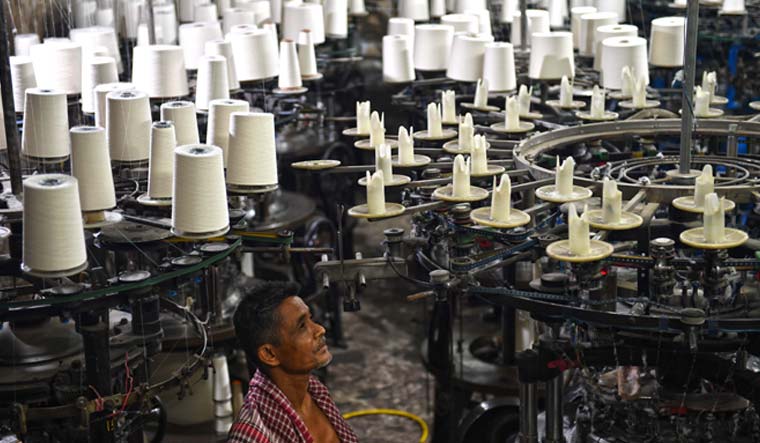The share of the textile sector in the total Indian merchandise exports declined from 24 per cent in 2001 to 11 per cent in 2020. Cotton yarn contribution in Indian export basket declined during the same period from 2 per cent to approximately 1 per cent, and Ready Made Garments (RMG) share of exports declined from 11 per cent to 4 per cent.
Exports are estimated to have accounted for 28 per cent in cotton yarn and 25 per cent in the RMG sector last financial year. As per a CRISIL report, lack of free trade agreements (FTAs) and significant improvement in peer competitiveness are the main causes for this dip. The report points out that textile is important to India’s $313 billion merchandise exports as it accounts for 11 per cent of the pie. The sector is also a significant employment generator and with 45 million direct employees and 60 million employees in allied industries, the sector is the second largest employment generating sector in India.
An analysis by CRISIL points out that India has lost market share in cotton yarn over the past decade to countries such as Vietnam and China due to high cost and lack of FTAs (Free Trade Agreements) amid intensifying competition. In RMG, India has done well to maintain its share even as global trade in the segment contracted. But competing countries such as Vietnam and Bangladesh have done much better as they have capitalised on China’s falling share in the past five fiscals, while India could not.
The report states that the Indian textiles players were pushed to the brink in 2020 as the Central government reduced export incentives in line with guidelines of the World Trade Organization. CRISIL Research has pointed out that it does not expect any significant improvement in incentives with the launch of the Remission of Duties and Taxes on Export Products (RoDTEP) scheme, which aims to reduce tax burden of exporting entities. However, to revive the textile value chain, the government has announced additional structural reforms whose impact needs to be evaluated.
The report observes that the recently announced PLI scheme for man-made fibres (MMF) and technical textiles is expected to improve the potential of MMF-based RMG exports where India’s share has been weak. Along with the integrated textile parks scheme, the PLI scheme may help the sector enhance its export share over the medium to long term, if implemented well. However, continuous support in terms of trade negotiations, more investments to improve infrastructure at larger scale may be needed. India is in a favourable position with China facing political backlash globally, but capitalising on this opportunity would need continuous and concerted effort.
Interestingly the CRISIL report highlights that despite the EU and the US being the largest RMG export destinations from the country with 32 per cent and 27 per cent share in 2020 respectively, India was unable to increase its presence there. On the other hand, while Bangladesh was able to improve its share in EU exports due to low cost of labour after abolition of quota system for developing nations, Vietnam increased its share in US exports as it acquired the most favoured nation (MFN) status in 2001.
also read
- Trump vs China could mean Rs 2 lakh crore windfall gain for India
- Which are India’s top 5 countries of import and export? Here is what govt data reveals
- Centre lifts onion export ban, imposes minimum export price of $550 per tonne
- India's exports rise 6.21 per cent to $33.57 billion in October: Govt data
Recently, however, the US imposed a ban on cotton and cotton-based products originating from Xinjiang region in China, which contributes more than 80 per cent in Chinas’ cotton production. Apparently since it is the largest cotton producing area globally, with around 20 per cent contribution, the ban is expected to affect the entire textile value chain. As a result, several RMG brands started looking for alternatives globally, and this led to a spike in Indian originated RMG exports since March 2021. This report says that this trend is expected to underpin India’s exports trajectory providing the country the much needed opportunity to re-establish relations with global brands.
As per the report over January-May 2021, cotton yarn or fabric and made-ups exports from India have grown at ~69 per cent and RMG exports have grown by 39 per cent. Even raw cotton exports have gone up by 55 per cent year-on-year basis during October 2020 to May 2021 to 5.8 million bales of 170 kg as the US and Brazil struggled with lower cotton production.
CRISIL says that Vietnam and Bangladesh enjoy lower duties and India needs to seep in trade agreements and low import duties in key export destinations. With changing global dynamics, India, too, can take advantage of the global need to reduce dependency on China and increase presence in global trade like Vietnam and Bangladesh, which are delivering the right products at competitive prices. However, for this, India will have to revamp its product portfolio, restructure incentive schemes and reduce cost.





